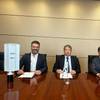The Navy rejected safety experts' recommendations that U.S. submarines be required to use "active" sonar before surfacing to avoid collisions like the one that sank a Japanese trawler off Hawaii. Active sonar sends out ping-like signals that bounce off objects and detects their range. Passive sonar uses a device called a hydrophone to amplify noises in a broader area. Contrary to a 1990 National Transportation Safety Board recommendation, commanding officers have complete discretion to decide which system to use under the circumstances, the Navy said. "We don't have a requirement to use active sonar," said Lt. Cmdr. Cate Mueller, a Navy spokeswoman at the Pentagon. "Passive sonar is best for tracking surface traffic because it looks in the broadest area at all times." Active sonar, on the other hand, "focuses narrowly in one direction," she said.
The five-member safety board, which investigates U.S. transportation accidents, made its recommendation after probing a 1989 mishap involving a tug and the nuclear-powered attack submarine USS Houston.
The Houston is a member of the same Los Angeles class of submarines as the USS Greeneville, which collided with the trawler Ehime Maru while surfacing nine miles south of Pearl Harbor, sinking the vessel and leaving nine people, including four high school students, missing at sea. On June 14, 1989, the Houston had been set to take part the next day in the filming of "The Hunt for Red October," a Cold War thriller based on Tom Clancy's best-selling novel. The accident in which it sank a tug occurred in a channel between Los Angeles and Santa Catalina Island off southern California.
As it ascended to periscope depth -- about 60 feet -- for a navigation fix, the Houston snagged the tow line of the tug Barcona, which had two empty barges in tow. According to the safety board, the Houston then went into an emergency descent and the force pulled the tug under water at the stern, drowning a crew member.
The board, which investigates accidents in U.S. waters involving at least one private vessel, blamed the accident on the Houston's failure to use active sonar to detect the tug's two-barge tow before surfacing.
In a Sept. 4, 1990, ruling, the independent, five-member body also faulted the submarine's "officer of the deck" for failing to recognize the tug's towing lights or their significance after the submarine reached periscope death.
It said using passive sonar to locate surface vessels was insufficient, although the active high-resolution sonar normally used during ascent to periscope depth was out of service on the Houston at the time.
The out-of-commission sonar "did not relieve the navigation watch from the responsibility of using other active sonar equipment that was available and operational," the board said.
The investigation found no apparent need for the Houston to maintain secrecy about its presence in the area. There was a "very good probability" that the use of active sonar would have detected the Barcona's tow and averted the accident, the commissioners ruled.
The board recommended that the Navy require the use of active sonar on all submarines ascending to periscope depth in U.S. coastal waters except in national security situations, when stealth is crucial.
It also urged the Navy to require adequate rest for submarine "officers of the deck" before they stand watch while the vessel is under way.
Mueller, the Navy spokeswoman, said making sure that such officers were properly rested long had been part of standard operating procedure, pre-dating the board's recommendation.
"We're aware of their recommendations and thank them for their thoughtful service in that investigation," she said. - (Reuters)
Featured videos

Inmarsat Enhances Service to Drive Digitalization

Unlock Onboard Data Efficiencies

Tracking Foreign Vessels Working in the U.S. Jones Act Market
Subscribe for
Maritime Reporter E-News
Maritime Reporter E-News is the maritime industry's largest circulation and most authoritative ENews Service, delivered to your Email five times per week









